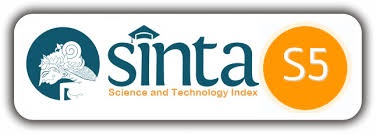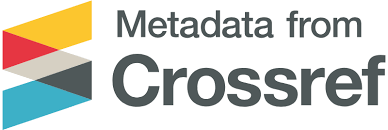Identifying English Needs and Challenges for Angklung and Bamboo Music Programs
Abstract
This study aims to identify the needs and challenges of English language learning as a key component of musical communication in the internationally recognized context of angklung and bamboo music. The needs analysis focuses on four themes: contextual musical needs, challenges specific to the music context, psychosocial influences, and relevant teaching strategies. The study employs a qualitative case study design using purposive sampling. Data were collected through three techniques: interviews with three music lecturers based on their expertise, classroom observations, and analysis of relevant documents. The data were analyzed using a six-stage qualitative analysis process. The findings reveal that current English instruction is not fully contextualized or applicable to the communicative needs of music, both spoken and written. Key challenges include limited academic writing skills and the insufficient integration of traditional music vocabulary with English. Student-related internal factors, such as lack of discipline and responsibility, also hinder the learning process. However, learning strategies that are engaging and aligned with musical practice can enhance students' English proficiency. Future research should focus more specifically on angklung and bamboo music contexts, including the development of appropriate teaching methods, standardized interactive angklung templates, and a glossary of traditional music terms with accurate English equivalents.
References
2. Basturkmen, H. (2010). Developin1. Anthony, L. (2018). Introducing English for specific purposes. Routledge. https://doi.org/10.4324/9781315269023
2. Basturkmen, H. (2010). Developing courses in English for specific purposes. Palgrave Macmillan.
3. Bhatia, V. K. (2011). ESP and genre analysis: The state of the art. English for Specific Purposes, 30(1), 1–19. https://doi.org/10.1016/j.esp.2010.11.001
4. Creswell, J. W. (2012). Qualitative inquiry & research design: Choosing among five approaches (3rd ed.). Sage.
5. Dai, Y., Wu, Z., & Dai, L. (2015). The relationships among motivation, learning styles and English proficiency in EFL music students. International Journal of English Linguistics, 5(6), 75–83. https://doi.org/10.5539/ijel.v5n6p75
6. Dewaele, J.-M., & MacIntyre, P. D. (2014). The two faces of Janus? Anxiety and enjoyment in the foreign language classroom. Studies in Second Language Learning and Teaching, 4(2), 237–274. https://doi.org/10.14746/ssllt.2014.4.2.5
7. Dewi, R. R. (2017). Developing a task-based ESP learning material for music department of SMM Yogyakarta (A research and development at the eleventh-grade students of SMK N2 Kasihan Bantul in the academic year of 2016/2017) [Unpublished doctoral dissertation]. Universitas Sebelas Maret, Indonesia.
8. Dörnyei, Z. (2001). Motivational strategies in the language classroom. Cambridge University Press.
9. Dörnyei, Z. (2005). The psychology of the language learner: Individual differences in second language acquisition. Lawrence Erlbaum Associates.
10. Drljača Margić, B. (2024). Students’ English language proficiency in English medium instruction: Teachers’ opinions, perceptions and practices. Zbornik radova Filozofskog fakulteta u Splitu, 17, 89–104. https://doi.org/10.38003/zrffs.17.4
11. Dudley-Evans, T., & St. John, M. J. (1998). Developments in English for specific purposes: A multi-disciplinary approach. Cambridge University Press.
12. Elder, C., & O'Loughlin, K. J. (2003, January). Investigating the relationship between intensive EAP training and band score gains on IELTS. [Conference paper]. ResearchGate. https://www.researchgate.net/publication/267633609
13. Gay, L. R., Mills, G. E., & Airasian, P. W. (2006). Educational research: Competencies for analysis and applications (8th ed.). Pearson Merrill Prentice Hall.
14. Graves, K. (2000). Designing language courses: A guide for teachers. Heinle & Heinle.
15. Hakim, D. N., & Suendarti, M. (2023). The perceptions of teachers regarding digital literacy and the English teaching learning process. INFERENCE: Journal of English Language Teaching, 6(1), 1–11. http://dx.doi.org/10.30998/inference.v6i1
16. Harding, K. (2007). English for specific purposes. Oxford University Press.
17. Hapsari, P. D. (2015). The need analysis of music department students to learn English by using the project-based approach with song lyrics writing as supporting technique. Promusika, 3(2), 137–148.
18. Harmandaoğlu Baz, E. (2023). What is up with English: A needs analysis for music students. Journal of Language Research, 7(1), 65–79. https://doi.org/10.51726/jlr.1374630
19. House, J. (2015). Translation quality assessment: Past and present. Routledge.
20. Hutchinson, T., & Waters, A. (1987). English for specific purposes: A learning-centred approach. Cambridge University Press.
21. Hyland, K. (2006). English for specific purposes: Theory and practice. Cambridge University Press.
22. Hyland, K. (2007). English for specific purposes: Some influences and impacts. In J. Cummins & C. Davison (Eds.), International handbook of English language teaching (pp. 379–390). Springer.
23. Hyon, S. (2018). Introducing genre and English for specific purposes. Routledge.
24. Kementerian Pendidikan dan Kebudayaan Republik Indonesia. (2019, 16 Februari). Belajar bermain angklung di Rembuk Nasional Pendidikan dan Kebudayaan 2019. https://www.kemdikbud.go.id/main/blog/2019/02/belajar-bermain-angklung-di-rembuk-nasional-pendidikan-dan-kebudayaan-2019
25. Kementerian Pendidikan dan Kebudayaan Republik Indonesia, Direktorat Jenderal Pendidikan Tinggi. (2011). Surat edaran Dirjen Dikti No. 455/E/T/2011 tentang publikasi karya ilmiah. Jakarta: Menteri Pendidikan dan Kebudayaan.
26. Kirkpatrick, A. (2020). English as an ASEAN lingua franca. In K. Murata (Ed.), The handbook of Asian Englishes (pp. 725–740). Wiley.
27. Kolb, D. A. (1984). Experiential learning: Experience as the source of learning and development. Prentice-Hall.
28. Krashen, S. D. (1982). Principles and practice in second language acquisition. Pergamon Press.
29. Kusumaningputri, R. (2010). English for specific purposes di Universitas Jember: Tantangan dan solusi. Jurnal Pengembangan Pendidikan, 7(2), 210–263.
30. Lewis, M. (1993). The lexical approach: The state of ELT and a way forward. Language Teaching Publications.
31. Mayer, R. E. (2009). Multimedia learning (2nd ed.). Cambridge University Press.
32. Nabung, A., Emilia, E., & Purnawarman, P. (2024). Challenges in integrating English for specific purposes into the Indonesian TEFL curriculum: A literature study. Premise: Journal of English Education and Applied Linguistics, 13(3), 817–841. https://doi.org/10.24127/pj.v13i3.8880
33. Nation, I. S. P. (2001). Learning vocabulary in another language. Cambridge University Press.
34. Nunan, D. (2004). Task-based language teaching. Cambridge University Press.
35. Omar, N. A., Mahadi, T. S. T., & Shakir, M. Z. (2021). English for specific purposes: Teaching challenges and needs analysis in technical and vocational education and training (TVET). Asian ESP Journal, 17(3), 45–62.
36. O'Reilly, D., & Marsden, E. (2023). Elicited metaphoric competence in a second language: A construct associated with vocabulary knowledge and general proficiency? International Review of Applied Linguistics in Language Teaching, 61(2), 287–327. https://doi.org/10.1515/iral-2021-0147
37. Richards, J. C. (2001). Curriculum development in language teaching. Cambridge University Press.
38. Setyono, B., & Widodo, H. P. (2019). The representation of multicultural values in the Indonesian Ministry of Education and Culture endorsed EFL textbook: A critical discourse analysis. Intercultural Education, 30(4), 383–397. https://doi.org/10.1080/14675986.2019.1548102
39. Tuan, N. H., & Mai, T. N. (2015). Factors affecting students’ speaking performance at Le Thanh Hien High School. Asian Journal of Educational Research, 3(2), 8–23.
40. Wakeland, L. (2013). Development of an English-for-specific-academic-purposes course for music students. Hong Kong Journal of Applied Linguistics, 14(2), 45–59.
41. Widodo, H. P. (2020). Approaches to research and development for ESP curriculum: Text-based, genre-based, and corpus-based. Springer. https://doi.org/10.1007/978-981-15-7960-8
42. Wikipedia. (2025, Juli). Angklung. Wikipedia. Diakses 24 Agustus 2025, dari https://en.wikipedia.org/wiki/Angklung
43. Wright, C. N. (2012). Educational orientation and upward influence: An examination of students' conversations about disappointing grades. Communication Education, 61(3), 271–289. https://doi.org/10.1080/03634523.2012.671949
44. Yampolsky, P. (2013). Indonesian performing arts in a global context. Asian Theatre Journal, 30(1), 48–67.
g courses in English for specific purposes. Palgrave Macmillan.
3. Bhatia, V. K. (2011). ESP and genre analysis: The state of the art. English for Specific Purposes, 30(1), 1–19. https://doi.org/10.1016/j.esp.2010.11.001
4. Creswell, J. W. (2012). Qualitative inquiry & research design: Choosing among five approaches (3rd ed.). Sage.
5. Dai, Y., Wu, Z., & Dai, L. (2015). The relationships among motivation, learning styles and English proficiency in EFL music students. International Journal of English Linguistics, 5(6), 75–83. https://doi.org/10.5539/ijel.v5n6p75
6. Dewaele, J.-M., & MacIntyre, P. D. (2014). The two faces of Janus? Anxiety and enjoyment in the foreign language classroom. Studies in Second Language Learning and Teaching, 4(2), 237–274. https://doi.org/10.14746/ssllt.2014.4.2.5
7. Dewi, R. R. (2017). Developing a task-based ESP learning material for music department of SMM Yogyakarta (A research and development at the eleventh-grade students of SMK N2 Kasihan Bantul in the academic year of 2016/2017) [Unpublished doctoral dissertation]. Universitas Sebelas Maret, Indonesia.
8. Dörnyei, Z. (2001). Motivational strategies in the language classroom. Cambridge University Press.
9. Dörnyei, Z. (2005). The psychology of the language learner: Individual differences in second language acquisition. Lawrence Erlbaum Associates.
10. Drljača Margić, B. (2024). Students’ English language proficiency in English medium instruction: Teachers’ opinions, perceptions and practices. Zbornik radova Filozofskog fakulteta u Splitu, 17, 89–104. https://doi.org/10.38003/zrffs.17.4
11. Dudley-Evans, T., & St. John, M. J. (1998). Developments in English for specific purposes: A multi-disciplinary approach. Cambridge University Press.
12. Elder, C., & O'Loughlin, K. J. (2003, January). Investigating the relationship between intensive EAP training and band score gains on IELTS. [Conference paper]. ResearchGate. https://www.researchgate.net/publication/267633609
13. Gay, L. R., Mills, G. E., & Airasian, P. W. (2006). Educational research: Competencies for analysis and applications (8th ed.). Pearson Merrill Prentice Hall.
14. Graves, K. (2000). Designing language courses: A guide for teachers. Heinle & Heinle.
15. Hakim, D. N., & Suendarti, M. (2023). The perceptions of teachers regarding digital literacy and the English teaching learning process. INFERENCE: Journal of English Language Teaching, 6(1), 1–11. http://dx.doi.org/10.30998/inference.v6i1
16. Harding, K. (2007). English for specific purposes. Oxford University Press.
17. Hapsari, P. D. (2015). The need analysis of music department students to learn English by using the project-based approach with song lyrics writing as supporting technique. Promusika, 3(2), 137–148.
18. Harmandaoğlu Baz, E. (2023). What is up with English: A needs analysis for music students. Journal of Language Research, 7(1), 65–79. https://doi.org/10.51726/jlr.1374630
19. House, J. (2015). Translation quality assessment: Past and present. Routledge.
20. Hutchinson, T., & Waters, A. (1987). English for specific purposes: A learning-centred approach. Cambridge University Press.
21. Hyland, K. (2006). English for specific purposes: Theory and practice. Cambridge University Press.
22. Hyland, K. (2007). English for specific purposes: Some influences and impacts. In J. Cummins & C. Davison (Eds.), International handbook of English language teaching (pp. 379–390). Springer.
23. Hyon, S. (2018). Introducing genre and English for specific purposes. Routledge.
24. Kementerian Pendidikan dan Kebudayaan Republik Indonesia. (2019, 16 Februari). Belajar bermain angklung di Rembuk Nasional Pendidikan dan Kebudayaan 2019. https://www.kemdikbud.go.id/main/blog/2019/02/belajar-bermain-angklung-di-rembuk-nasional-pendidikan-dan-kebudayaan-2019
25. Kementerian Pendidikan dan Kebudayaan Republik Indonesia, Direktorat Jenderal Pendidikan Tinggi. (2011). Surat edaran Dirjen Dikti No. 455/E/T/2011 tentang publikasi karya ilmiah. Jakarta: Menteri Pendidikan dan Kebudayaan.
26. Kirkpatrick, A. (2020). English as an ASEAN lingua franca. In K. Murata (Ed.), The handbook of Asian Englishes (pp. 725–740). Wiley.
27. Kolb, D. A. (1984). Experiential learning: Experience as the source of learning and development. Prentice-Hall.
28. Krashen, S. D. (1982). Principles and practice in second language acquisition. Pergamon Press.
29. Kusumaningputri, R. (2010). English for specific purposes di Universitas Jember: Tantangan dan solusi. Jurnal Pengembangan Pendidikan, 7(2), 210–263.
30. Lewis, M. (1993). The lexical approach: The state of ELT and a way forward. Language Teaching Publications.
31. Mayer, R. E. (2009). Multimedia learning (2nd ed.). Cambridge University Press.
32. Nabung, A., Emilia, E., & Purnawarman, P. (2024). Challenges in integrating English for specific purposes into the Indonesian TEFL curriculum: A literature study. Premise: Journal of English Education and Applied Linguistics, 13(3), 817–841. https://doi.org/10.24127/pj.v13i3.8880
33. Nation, I. S. P. (2001). Learning vocabulary in another language. Cambridge University Press.
34. Nunan, D. (2004). Task-based language teaching. Cambridge University Press.
35. Omar, N. A., Mahadi, T. S. T., & Shakir, M. Z. (2021). English for specific purposes: Teaching challenges and needs analysis in technical and vocational education and training (TVET). Asian ESP Journal, 17(3), 45–62.
36. O'Reilly, D., & Marsden, E. (2023). Elicited metaphoric competence in a second language: A construct associated with vocabulary knowledge and general proficiency? International Review of Applied Linguistics in Language Teaching, 61(2), 287–327. https://doi.org/10.1515/iral-2021-0147
37. Richards, J. C. (2001). Curriculum development in language teaching. Cambridge University Press.
38. Setyono, B., & Widodo, H. P. (2019). The representation of multicultural values in the Indonesian Ministry of Education and Culture endorsed EFL textbook: A critical discourse analysis. Intercultural Education, 30(4), 383–397. https://doi.org/10.1080/14675986.2019.1548102
39. Tuan, N. H., & Mai, T. N. (2015). Factors affecting students’ speaking performance at Le Thanh Hien High School. Asian Journal of Educational Research, 3(2), 8–23.
40. Wakeland, L. (2013). Development of an English-for-specific-academic-purposes course for music students. Hong Kong Journal of Applied Linguistics, 14(2), 45–59.
41. Widodo, H. P. (2020). Approaches to research and development for ESP curriculum: Text-based, genre-based, and corpus-based. Springer. https://doi.org/10.1007/978-981-15-7960-8
42. Wikipedia. (2025, Juli). Angklung. Wikipedia. Diakses 24 Agustus 2025, dari https://en.wikipedia.org/wiki/Angklung
43. Wright, C. N. (2012). Educational orientation and upward influence: An examination of students' conversations about disappointing grades. Communication Education, 61(3), 271–289. https://doi.org/10.1080/03634523.2012.671949
44. Yampolsky, P. (2013). Indonesian performing arts in a global context. Asian Theatre Journal, 30(1), 48–67.
Copyright (c) 2025 Denhaz Nurul Hakim, Hinhin Agung Daryana

This work is licensed under a Creative Commons Attribution-ShareAlike 4.0 International License.













